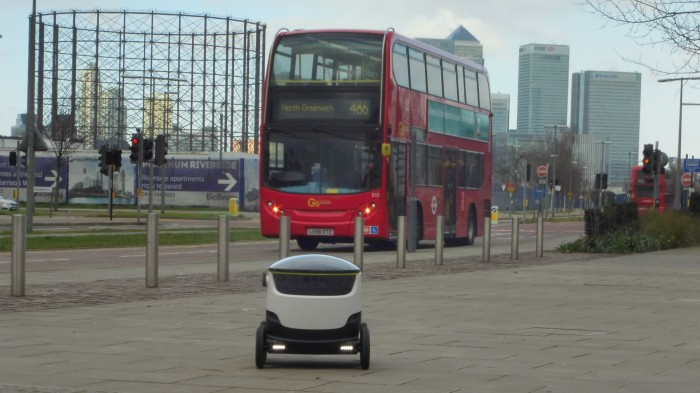This Plucky Robot Will Blaze a Trail Carrying Pizza
In a matter of weeks some Londoners will have the chance to have food delivered aboard a small robot. Starship Technologies, which makes the wheeled delivery bots, announced today that it has tied up deals with two delivery startups, Just Eat and Pronto.
It’ll be interesting to see how the robots fare when they are unleashed into the real world, especially when they encounter potentially hostile and hungry humans as they go about their work.
These won’t be the first robots to move among us. Others are popping up in stores, hotels, and parking lots at a surprising rate. Still, operating on the open pavement among ordinary pedestrians will present unique challenges, not least figuring out who has the right of way.

Navigating unfamiliar territory would be a tricky problem for robots, so the delivery bots will only be able to roam a few miles, covering ground they have mapped before—at the dizzying top speed of 4 mph.
A while ago, I spoke with the chief operating officer of Starship, Allan Martinson. He explained that one of the most challenging issues it has faced is designing its robots to respond to curious or confused bystanders. For that reason, the company has had people following its robots, ready to intervene if necessary. But the company now says that its robots have “met over 400,000 people without an accident.”
A late-night delivery might be riskier proposition. And as the unfortunate story of Hitchbot, a hitchhiking robot that was decapitated in Philadelphia, showed us, people can be pretty awful to an unsuspecting robot when no one is looking.
Still, assuming the robot makes it to your front door in one piece, at least it probably won’t expect a tip.
(Sources: Engadget, CNN, “Robots Are Invading Malls (and Sidewalks) Near You,” “Robots Learn How to Make Friends and Influence People”)
Keep Reading
Most Popular
Large language models can do jaw-dropping things. But nobody knows exactly why.
And that's a problem. Figuring it out is one of the biggest scientific puzzles of our time and a crucial step towards controlling more powerful future models.
How scientists traced a mysterious covid case back to six toilets
When wastewater surveillance turns into a hunt for a single infected individual, the ethics get tricky.
The problem with plug-in hybrids? Their drivers.
Plug-in hybrids are often sold as a transition to EVs, but new data from Europe shows we’re still underestimating the emissions they produce.
Stay connected
Get the latest updates from
MIT Technology Review
Discover special offers, top stories, upcoming events, and more.